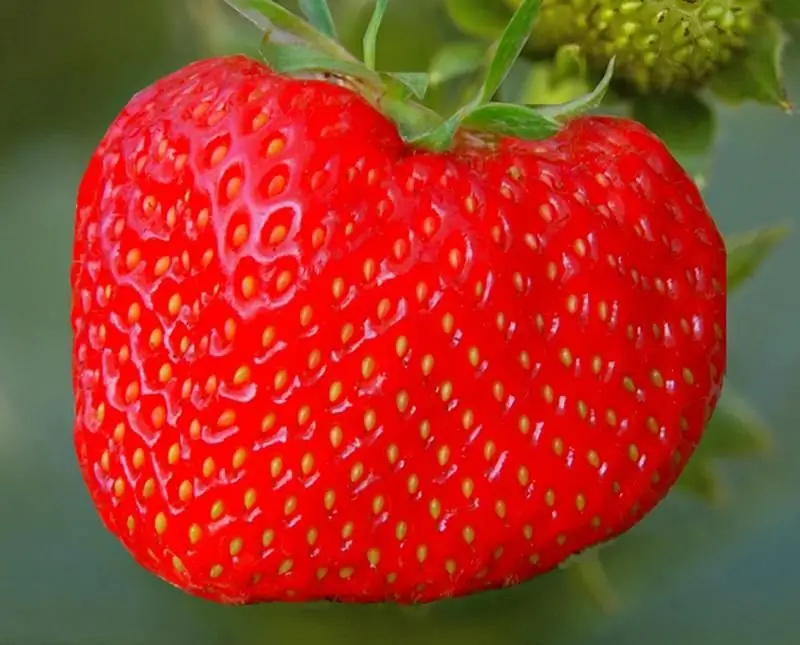
Table of contents:
- Queen Elizabeth is the royal person among the remontant garden strawberries
- Description and characteristics of the garden remontant strawberry Queen Elizabeth
- Planting and leaving
- Breeding strawberries and planting them in the garden
- Diseases and pests
- Collection, storage and use of crops
- Reviews of gardeners about the strawberry variety Queen Elizabeth
- Author Bailey Albertson [email protected].
- Public 2024-01-17 22:26.
- Last modified 2025-06-01 07:32.
Queen Elizabeth is the royal person among the remontant garden strawberries
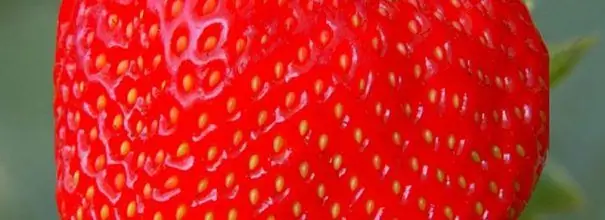
In Russia, the garden strawberry Queen Elizabeth appeared relatively recently, but it is difficult to find a gardener who would not have heard of this variety, and for many he has already settled in the beds, although most of them learn about the variety not from descriptions and photos in advertising publications, but from friends. Maybe that's why many call it strawberries out of a long-term habit. But no matter how they call this berry, they value it not for the name, but for the qualities that distinguish it favorably from other similar varieties. Let's try to figure out what is the secret of Queen Elizabeth's popularity.
Content
-
1 Description and characteristics of the garden remontant strawberry Queen Elizabeth
- 1.1 Why garden strawberries are called strawberries
-
1.2 Varieties Queen Elizabeth and Elizabeth 2
- 1.2.1 Table: Comparative description of the varieties Queen Elizabeth and Elizabeth 2
- 1.2.2 Photo Gallery: Royal Berries
- 1.2.3 Video: The Harvest of Queen Elizabeth
- 1.2.4 Table: advantages and disadvantages of varieties
-
2 Planting and care
- 2.1 Planting site selection and soil preparation
- 2.2 Planting time and arrangement of bushes
-
2.3 Top dressing and watering
2.3.1 Table: types of dressings used when caring for strawberries
- 2.4 Preparing for winter
-
3 Reproduction of strawberries and planting them in the garden
- 3.1 Reproduction of strawberries with a mustache
- 3.2 Bush division
- 3.3 Sowing seeds
-
3.4 Planting strawberries in a permanent place
- 3.4.1 Planting seedlings with open roots
- 3.4.2 Planting seedlings in plastic cups
-
4 Diseases and pests
- 4.1 Table: main diseases and pests
- 4.2 Photo gallery: you need to know enemies by sight
-
5 Collection, storage and use of crops
5.1 Video: making pastilles and drying strawberries
- 6 Reviews of gardeners about the strawberry variety Queen Elizabeth
Description and characteristics of the garden remontant strawberry Queen Elizabeth
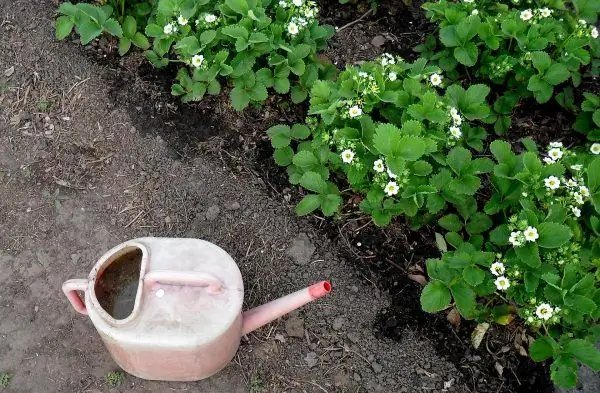
A rare suburban area does without a strawberry bed
Garden strawberries are a very common berry. Rarely does a summer cottage do without strawberry beds. But for some reason such a popular culture is very often called by the name of another berry - strawberry.
Why garden strawberries are called strawberries
The Strawberry genus includes up to 100 plant species. These are wild strawberries, forest, green, nutmeg, Bukhara, Chilean, Virginia and others. The crossing of the latter two species gave birth to large-fruited pineapple strawberries, from which all modern cultivated varieties have gone.
In Russia, wild strawberries were called strawberries (grows near the ground), and green strawberries (steppe, half-moon) were called strawberries (the shape of a berry, like a tuber); It was also called musk strawberry, but it is much less common in nature, although it has been grown in the gardens of Russia since the 17th century.
When, at the end of the 19th century, large-fruited garden strawberries were brought from abroad to Russia and began to grow them massively instead of musk strawberries (strawberries), the name strawberry was inherited from it - so people were more familiar with it. The situation was also confused by the fact that by the name of one of the first varieties of garden strawberries, long forgotten, they began to call it Victoria. In the villages, until recently, one could hear: "Strawberries in the field, and in the garden - Victoria".
So, both wild strawberries and strawberries grow in the wild in our country. Both are good, but each has its own taste and appearance.
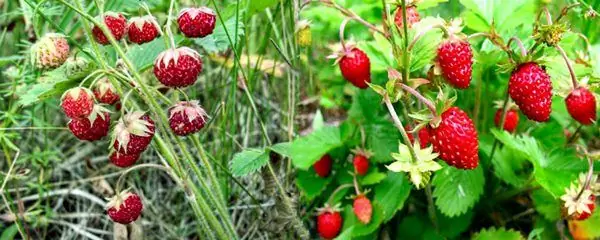
Strawberry on the left, strawberry on the right
The photo clearly shows the differences in the shape and color of the berries. Garden remontant strawberry Queen Elizabeth has gone far from her wild relatives in terms of yield, size of berries, ability to bear fruit almost from spring to the very snow.
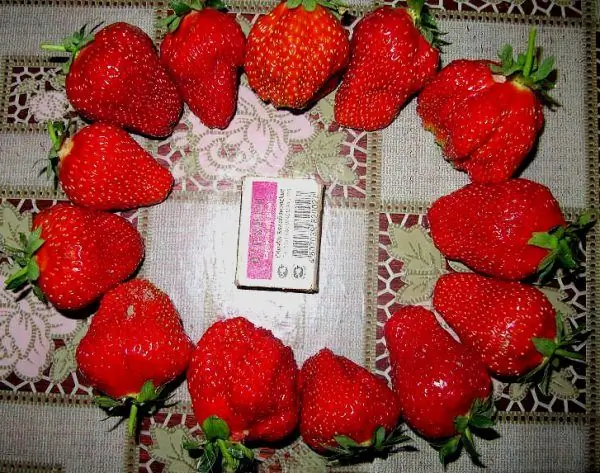
The royal berry also has royal sizes
So, let's remember: strawberries have not been grown in our gardens since the 19th century, unless they were brought from the forest by a lover of true strawberry taste and aroma. But this is in theory, but in life you may be surprised to look at the market if you ask to weigh a large-fruited garden strawberry - this is how the name strawberry has grown together with it.
Varieties Queen Elizabeth and Elizabeth 2
In our country, there are two similar varieties of remontant garden strawberries with similar names - Queen Elizabeth and Elizabeth 2. They also have a lot in common in terms of their main characteristics. As stated in Runet, the remontant variety of garden strawberries Queen Elizabeth appeared in Russia at the turn of the 20th and 21st centuries. Its author is considered to be the famous English breeder Ken Muir. But it seems that the strawberry got this name already in Russia: on the website of Ken Muir, who died in 2011, there is no such thing among 21 varieties of strawberries offered for sale.
But the origin of Elizabeth 2 is associated with the research and production company "Donskoy Nursery" in the Rostov region, which was one of the first in Russia to start working with Queen Elizabeth. And in 2000, among the plantings, several bushes were noticed, distinguished by a special size of berries, an increased shoot-forming ability and a longer fruiting cycle, with which the selection work was continued. In 2004, the variety was included in the official State Register of Breeding Achievements Permitted for Use.
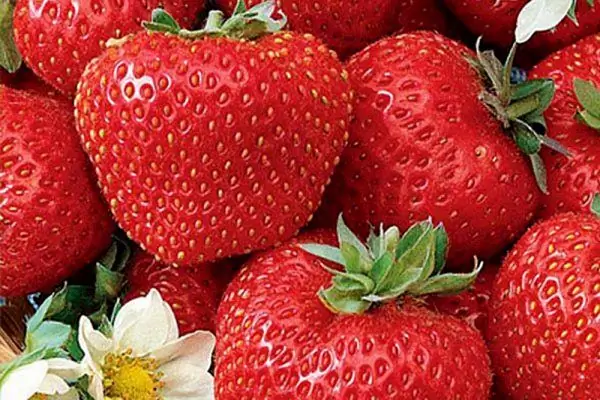
Already at the end of April, residents of the southern regions can treat themselves to the berries of the remontant strawberries Elizabeth 2
Table: Comparative description of the varieties Queen Elizabeth and Elizabeth 2
| Characteristic | Queen Elizabeth | Elizabeth 2 |
| Ripening terms | from early June to September. | Mid-May to September. |
| Yield per bush, kg | up to 2. | up to 2. |
| The appearance of the bushes | Semi-spreading. | Erect, semi-spreading, larger. |
| Berry appearance | Scarlet, dense, shiny. | Dark scarlet, dense, shiny. |
| Berry weight, g | 20-40, maximum and very rarely 100. | 30-50, maximum and very rarely 125. |
| Tasting assessment | 4.4. | 4.7. |
| Vegetative ability | Average. | High. |
| Life span, years | 2. | 3. |
These new varieties of remontant garden strawberries are classified as neutral day varieties.
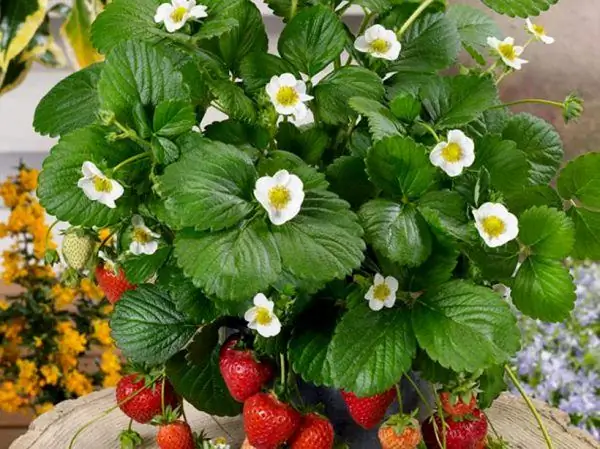
Would you like to treat yourself to strawberries in winter? Root the mustache in pots and transfer it to the windowsill for the winter. There they can be grown, at the same time collecting a home crop
As you can see from the table, the characteristics are very similar, but in general, the Elizaveta 2 variety looks preferable.
Photo gallery: berries of royal varieties
-

Queen Elizabeth Berries - Queen Elizabeth has juicy scarlet berries
-

Elizabeth Berries 2 - Elizabeth 2 Berries are darker than Queen Elizabeth
-

Queen Elizabeth - Berries pull the stems of Queen Elizabeth to the ground
-

Elizabeth Harvest 2 - Elizabeth 2 pleases her owners with a bountiful harvest
-

Terms of fruiting - Both varieties can be harvested until late autumn.
Video: Queen Elizabeth's Harvest
Table: advantages and disadvantages of varieties
| Advantages | disadvantages |
| High productivity. | Demanding for regular feeding. |
| Long fruiting period. | |
| Great taste and beautiful appearance of the berries. | |
| Winter hardiness and drought resistance. | |
| Good transportability, allowing you to grow berries for sale. | |
| Resistance to fungal diseases. |
Planting and leaving
Both of these varieties of remontant garden strawberries are characterized by intensive fruiting, therefore, they are demanding on the composition of the soil and depend on regular fertilization and watering. The soil must provide strawberries with all the necessary substances for successful development. Since the requirements for planting and care are identical for both varieties, in the text we will only mention the original variety - Queen Elizabeth.
Planting site selection and soil preparation
- the most illuminated place with fertile soil of neutral acidity is what is required for the successful growth of the Queen. Low-lying areas, as well as a high level (up to 1 m) of groundwater, are categorically unsuitable. In this case, you can arrange bulk beds, on which, by the way, it is convenient to care for the plants. The preparation of the site should be done one month before planting. If strawberries are planted in spring, then the garden must be prepared in the fall;
- Do not put strawberries on an area where pumpkin, cruciferous and solanaceous crops grew in previous years. The best predecessors will be green manure, onion, garlic, radish, carrot, parsley, salad;
- it is possible to bring the reaction of the soil with acidic to neutral by introducing dolomite flour, slaked lime, cement dust at the rate of about 300 g / m 2. You can also use wood ash 500 g / m 2;
- loamy soil must be enriched by introducing organic matter: 2-5 buckets (depending on the soil condition) of rotted manure or compost per square meter. It is also necessary to add a complete mineral fertilizer such as Kemira - 5 tablespoons per square meter.
- the soil is dug up deeply, by 30 cm, with the removal of weeds, stones, insect larvae.
Planting time and arrangement of bushes
Queen Elizabeth strawberries can be planted from spring to autumn, but the autumn planting should not be dragged out too long, the plant must have at least a month for survival before wintering. Therefore, if strawberries are planted in September, cover the bushes with non-woven material, they will take root faster under cover. The buds that appear must be cut off. You can plant strawberries in early spring, in mid-April, but you also need to part with the first peduncles, then the strawberries will yield a late harvest, but it will be more abundant. The best time for planting according to the rules of agricultural technology is July-early August. The bulk of the buds that will appear must be removed again so that the strawberries take root and leave before winter in good condition, and a few left flowers will give the opportunity to taste the berry in September.
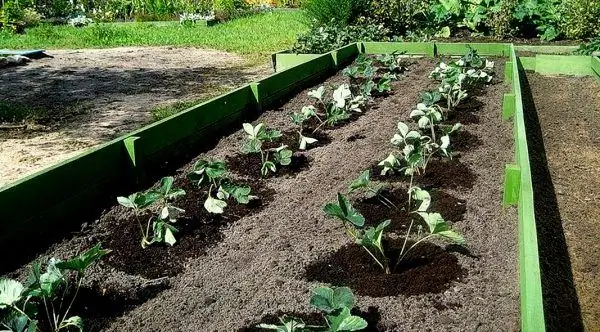
A well-lit place, fertile land - necessary conditions for the successful growth of Queen Elizabeth
There are two main schemes for planting bushes:
- single-row with a distance between plants of 20-30 cm and 60-70 cm between rows;
- two-line staggered. The distance between plants and rows is 20-25 cm, and between rows 1 m.
Recently, the method of growing garden strawberries on the ground covered with non-woven material with a density of 60 g / m 2 (agrofibre) has become very popular.
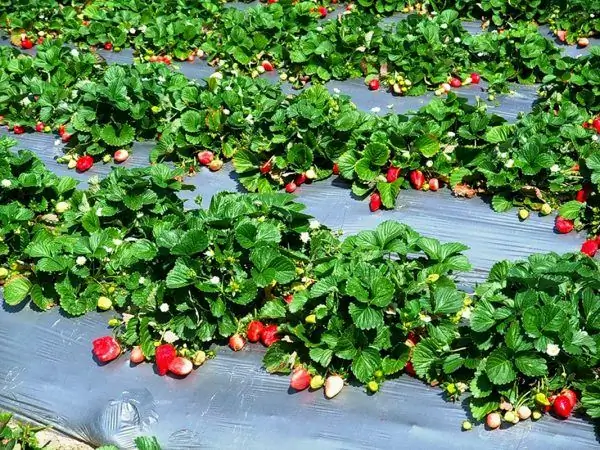
Growing garden strawberries on agrofibre-covered soil can provide a significant yield increase
This method has a number of undoubted advantages:
- additional heating of the soil is provided in spring and autumn;
- there are no weeds on such a bed;
- the film allows precipitation to pass through, but prevents moisture evaporation from the soil surface;
- berries stay clean in any weather.
As a result, the yield increase can be up to 50%. This method is especially effective on raised beds.
Top dressing and watering
Once again, we draw your attention to the fact that only regular feeding and systematic watering can provide Queen Elizabeth's declared yield. The root system of the plant is located close to the surface of the earth, and loosening the soil is fraught with damage to the roots. Therefore, if the garden bed is not protected by covering material, be sure to mulch it with compost, humus, sawdust, cut grass, etc.
Table: types of dressings used when caring for strawberries
| Fertilization method | Fertilizer composition | Cooking method |
| Foliar dressing (spraying) at the beginning of the growing season | Herbal infusion | Per barrel: 1 part of grass + 2 parts of water + 1 package of Radiance-3 preparation to speed up the fermentation process. Keep in the sun for 10 days, then stir, strain and dilute ten times with water. |
| Biohumus liquid | 1 glass to 10 liters of water, leave for 24 hours and dilute in a 1: 1 ratio. | |
| Ammonia | 2 tablespoons to 10 liters of water. | |
| Root feeding during the growing season | Herbal infusion | The concentration increases 2 times compared with foliar dressing, 0.5 liters under a bush. |
| Biohumus | 0.5 kg per 1m 2, then water. | |
| Ammonia | The concentration increases by 2 times compared with foliar dressing, 0.5 liters under a bush after watering. | |
| Manure infusion | Per barrel: 1 part manure + 2 parts water. Stir, leave for 10 days. Then mix again, strain and dilute with water tenfold. | |
| Ash | 1 glass of ash + 1 liter of water are mixed and infused for a day. Then the volume of the solution is increased with water to 10 liters and mixed again. Irrigation rate 2 l / m 2. | |
| Ammonium nitrate or urea | 1 matchbox per bucket of water, watering rate according to the instructions for the preparations. | |
| Complex mineral fertilizers | Preparations Solution, Kristallin, Kemira lux according to the instructions for them. | |
| Root feeding at the end of the growing season (September) | Autumn Kemira | According to the instructions for the drug. |
| Ash | Sprinkle 0.5 cups under each bush and water liberally. |
The first foliar dressing is done when leaf buds start to grow, repeat after 2 weeks. Spraying is carried out in the evening hours in dry weather, trying to moisten the lower surface of the leaves as much as possible, no matter how inconvenient it may seem. At the beginning of the ripening of the berries, they switch to root fertilization.
Root dressing is also carried out at intervals of 1-2 weeks, therefore, taking into account the foliar, their total amount per season will be 12-15 - this is the payment for the almost continuous fruiting of Queen Elizabeth. The table recommends 7 types of fertilizers, this does not mean that they should be applied simultaneously. Choose 2-3 formulations and add them regularly. It is only necessary to take into account that ammonium nitrate and urea are fertilizers of spring - early summer. And do not overdo it with organic matter, otherwise, instead of harvesting berries, you can get a harvest of mighty green leaves.
Autumn root top dressing is required to restore a plant weakened by fruiting and bookmark the next year's harvest. The potassium present in it will ensure the winter hardiness of the plant, resistance to fungal diseases, and will contribute to the accumulation of sugars in the fruits.
Watering with warm water should be frequent and moderately abundant. With sufficient precipitation, it is convenient to combine it with root dressing. Water more frequently in dry, hot weather. Rake the mulch and check the condition of the soil at a depth of 2-3 cm. If it is wet, then we postpone watering. Excess moisture during ripening makes the strawberries watery and less sweet. Do not pour water at the very root, then a rosette with roots suitable to it may be exposed, the development of the bush will slow down. If possible, it is worth organizing drip irrigation that does not erode the soil.
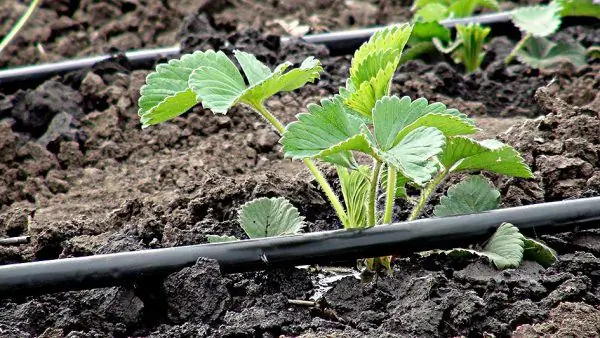
With drip irrigation, water is rationally consumed, the roots of strawberries are not exposed from soil erosion
Preparing for winter
- Combine the September feeding of strawberries with good watering: about 5 liters of water per adult bush with an eye, of course, to the rains;
- cut off diseased leaves close to the ground;
- gently rake loose debris from the garden bed, including fallen leaves;
- restore mulch in places of its absence;
- remove old fruit bearing, extra mustache;
- cover the bed with breathable material: lutrasil, spunbond, etc., without pulling it over the arcs.
This completes the preparation for the winter.
Breeding strawberries and planting them in the garden
There are 3 ways to reproduce garden strawberries, we list them in order of prevalence:
- With a mustache.
- By dividing the bush.
- With the help of seeds.
Propagation of strawberries with a mustache
In Elizabeth 2, the mustache is formed in sufficient quantity (which cannot be said about Queen Elizabeth), therefore this is the most common method. One or more bushes are selected, at which peduncles are cut off, so that all the forces of the bush go to the formation of a mustache. These shoots are capable of self-rooting, but it will not be superfluous to pin them to the ground in the place of root formation, having previously removed the mulch in this place. In a month and a half, they will already root well in the ground, and it will be possible to cut the “umbilical cord” connecting them with the mother plant, and in another week, plant them in a permanent place.
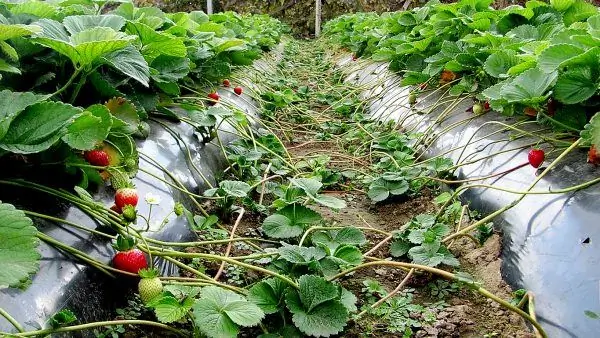
The most common way to breed strawberries is with a mustache.
If the bed is covered with non-woven material, then rooting is carried out in containers with soil, placed next to the mother bush, not forgetting to keep the soil in them moist.

In a bed with non-woven material, the mustache is rooted in cups with soil
Dividing the bush
This method is suitable for Queen Elizabeth if her mustache is not enough to breed the variety. For this, in the summer of the year following planting, strong and healthy bushes with 2-3 rosettes (horns) are selected and dug out. Having shaken off the earth from the bushes, they carefully divide the bush into parts according to the number of horns, if necessary, using a sharp, clean knife. Places of cuts are sprinkled with crushed coal. Divided bushes can be transplanted to a new location.
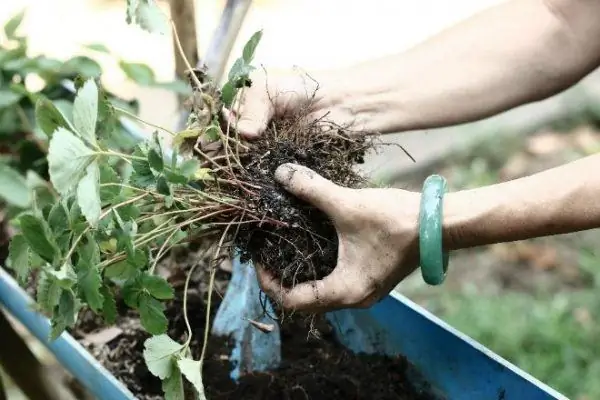
When dividing a bush, it is necessary to minimize damage to the root system
Sowing seeds
This is the most time consuming method. You should not try to get seeds from ripe berries on your own, there is a very high probability that the generic properties of the variety will be lost. It is better to purchase seeds from a trusted company in the store. Please note that the sale of seeds of remontant varieties, even in bags, is carried out by pieces, and not by weight, their germination rate can only be about 50%.
The sequence of growing seedlings from seeds is as follows:
- let's not bother with lighting and plant them in early March, after soaking the seeds in the natural preparation HB-101. Without such soaking, seedlings can appear only after a month, and with it - after a few days;
- we prepare the substrate for seedlings from a mixture of fertile soil and clean river sand in a 1: 1 ratio, you can use peat tablets;
- Pour the prepared substrate in containers up to 10-15 cm deep, and on top place a thin (about 2 mm) layer of sand. Sprinkle the substrate with water and sow seeds on it at intervals of 5-10 cm, slightly pressing them into the surface layer. We also slightly press the seed into a moistened peat tablet and place it in a container;
- close the containers with lids and put them in a warm place;
- air the containers daily, gradually increasing the gap of the slightly open lid;
- when the first seedlings appear in the peat pellet, it is necessary to remove the forming mesh from it and place it in a container with earth;
- seedlings are considered ready for planting when they already have 2-3 well-developed healthy leaves.

Growing strawberries from seeds is a rather troublesome process
Planting strawberries in a permanent place
No matter how we got the seedlings, or maybe they just gave us a few bushes of royal strawberries, they need to be planted correctly. To do this, planting pits measuring 20x20x20 cm are dug on the beds prepared in advance. The arrangement of the bushes was described above.
Planting seedlings with an open root system
- If the seedlings are obtained by dividing a bush or dug up from neighbors, and the root system is open, then we carefully examine the foliage and leave 3-4 of the healthiest leaves, and cut the roots so that they are no more than 10 cm, removing all suspicious well-being.
- Soak the roots for 2-3 hours in a solution of HB-101 (3 drops per 1 liter of water).
- We pour an earthen mound into the planting hole, spread the plant roots around it and slowly sprinkle it with earth, slapping it to eliminate voids. The strawberry socket should eventually be at ground level or slightly higher (1-2 cm).
Planting seedlings in plastic cups
- Water the seedlings an hour before planting.
- We carefully take out the seedlings, then proceed according to paragraphs 1-3 of the paragraph above.
We water the planted plants well, spending about 0.5 liters of water for each bush, mulch the soil with a layer of at least 5 cm and cover it with a light non-woven material for 2 weeks. For better rooting, you can add HB-101 to the water for irrigation (3 drops per liter).
Diseases and pests
Queen Elizabeth is quite resistant to fungal diseases, insects can be more problematic. Nevertheless, one must know the enemy by sight and be able to fight him.
Table: main diseases and pests
| Diseases or pests | Signs of defeat | Control measures |
| Gray rot | One of the most common fungal diseases. A moist gray mass of fungal spores appears on the fruit. Crop losses can be very significant. |
Spraying is done on the underside of the leaves. |
| Powdery mildew | Strawberry leaves become, as it were, sprinkled with flour, starting with small specks, ending with almost the entire surface. In this case, the mycelium changes color to gray, purple, brown. | |
| White and brown spots | With white spot, purple spots appear on the outside of the leaves with a white center point. The brown (angular) spot starts on the underside of the leaf and then spreads to the entire leaf. Red-brown spots appear, increasing in size, the affected part of the leaf breaks off. Sepals dry on fruits, berries lose their taste. Loss of yield in case of mass infestation with spotting can reach 30%. | |
| Raspberry and strawberry weevil | The name of this small black bug was given by its long proboscis. The female gnaws a hole in the strawberry bud, lays eggs in it, and then gnaws the pedicel, which is then doomed to death. The "productivity" of one weevil can reach 30 buds. Particular harm is done in thickened plantings. |
|
| Strawberry mite | Unlike the weevil, the tick is hard to see - its size is only 0.2 mm. But the results of its activity are obvious: after the female has laid eggs, the larvae that appear feed on young leaves. These leaves shrivel, slow down development, the bush looks dwarf compared to healthy plants, the berries greatly lose in size. Such bushes usually do not survive overwintering. | The mite is very difficult to remove. You can try Fitoverm. It is useful to plant garlic and marigolds along the edges of the garden. |
| Chafer | May beetle larvae spend 3 years in the soil and feed on plant roots. Strawberry roots are some of their favorites. |
|
| Snails, slugs | Snails and slugs leave characteristic silvery paths on the leaves and fruits of strawberries, gnaw out the leaves, and eat the fruits. |
|
The drugs mentioned in the table are used strictly according to the instructions for them.
Photo gallery: you need to know enemies by sight
-

Brown spot - The massive development of brown spotting leads to damage and death of a significant part of the leaves, which reduces the productivity of plantings in the next season
-

Strawberry mite - The strawberry mite feeds on the sap of the leaves, causing them to curl, dry and fall off
-

May beetle larva - The incredibly voracious beetle larvae gnaw and destroy the roots of strawberries
-

Raspberry and strawberry weevil - Sometimes you can see pedicels without buds on the bushes of garden strawberries. So the strawberry-raspberry weevil damages strawberries - a beetle of grayish-black color up to 3 mm long
-

Powdery mildew - Powdery mildew is a disease that can affect all aerial parts of the garden strawberry bush. Affected leaves curl up in a boat, gradually becoming purple, with a mealy bloom
-

Gray rot - The berry is covered with gray mold spores
-

Slug - If left to chance, slugs can completely destroy an area with strawberries in one season.
Collection, storage and use of crops
If you provide Queen Elizabeth with proper care, then you can eat plenty of fresh berries and make preparations for the long winter. Strawberries are harvested in dry weather, the stalks are not removed from the berries. Although the berry is quite dense, it is better not to put more than 2-3 layers of berries in a container. Strawberries are stored without loss of taste in the refrigerator for about 10 days, in room conditions - up to 3-4 days.
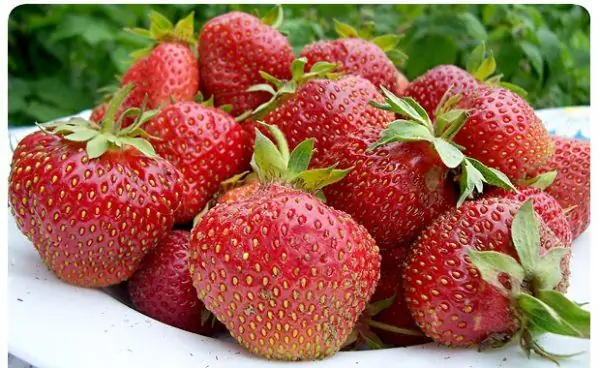
Berries, as for selection, you can cook anything from them
Some gardeners freeze berries. Strawberries retain their shape well in jam, but not everyone loves its sugary taste, despite the enchanting aroma. But what you should definitely do is strawberry pastille, try it.
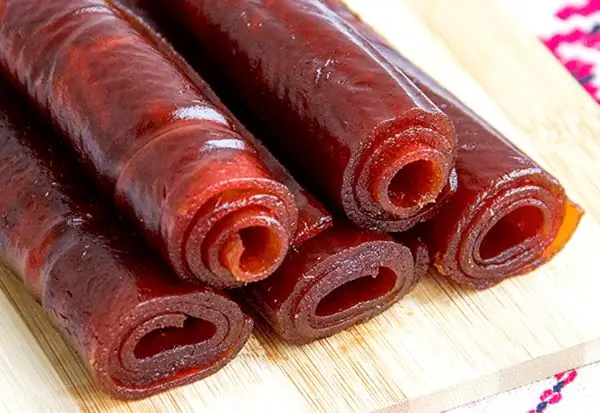
Strawberry candy, or, as it is also called fig, is a tasty and healthy delicacy
Video: making marshmallows and drying strawberries
Reviews of gardeners about the strawberry variety Queen Elizabeth
The garden strawberry variety Queen Elizabeth stands out among other remontant varieties with high yields, but it is achieved not by itself, but by rather intensive agricultural technology, albeit simple. The variety is resistant to fungal diseases, they can only remind of themselves in a humid cool time. The shoot-forming ability of the bushes is small, the strawberries do not spread with a carpet in the garden, so there is a problem with reproduction, because plantings must be replaced with new ones every 2 years. Still, it is worth trying to breed such a fruitful variety on your site - 2 kilograms of berries from one bush justify all the trouble.
Recommended:
All About Strawberries Black Prince - Description Of The Variety, Planting, Care And Other Aspects + Photo

Among the variety of varieties of garden strawberries, the Black Prince stands out with an unusual color of berries. Description of the variety and rules for planting care
A Variety Of Garden Strawberries (or Strawberries) Kimberly - Description, Care And Other Features + Photo
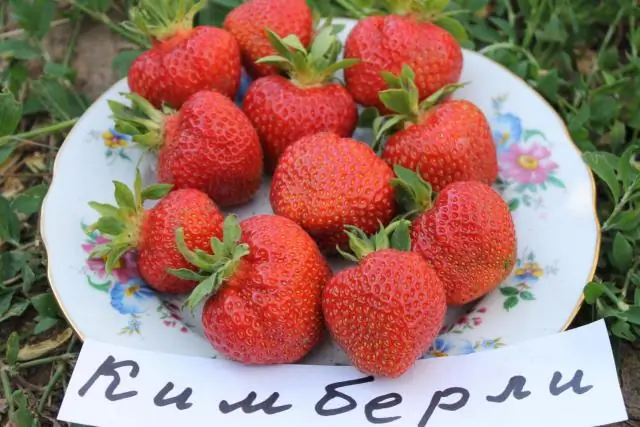
Information on planting and breeding of Kimberley strawberries (strawberries), care, planting, harvesting. Description of the variety. Reviews of gardeners about Kimberly strawberries
Chamora Turusi Variety Of Garden Strawberries - Features, Care And Other Important Aspects, The Difference Between Strawberries And Garden Strawberries + Photo

Everything about the Chamora Turusi strawberry variety: from planting and care to picking berries. Productivity, terms of fruiting, reviews of gardeners
Everything About Aggressor Cabbage - Variety Description, Planting, Care And Other Aspects + Photo

Features of growing cabbage Aggressor in order to obtain a high yield, its taste, appearance. Pest and disease control methods
All About Garden Strawberries (strawberries) Varieties Asia - Description, Planting, Care And Other Nuances + Photo
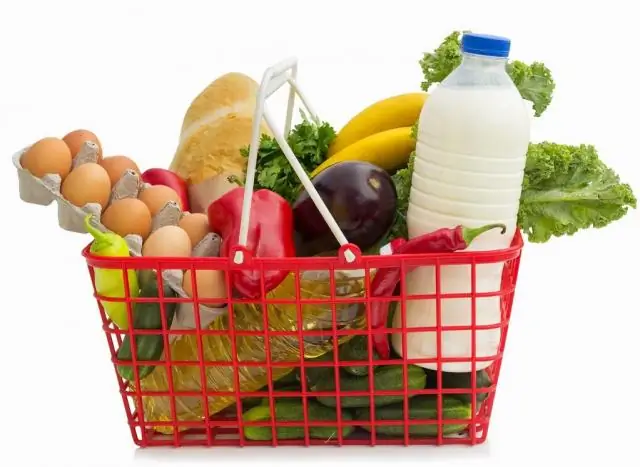
Description of the variety of garden strawberry Asia. Differences between strawberries and strawberries. Planting, care, reproduction. Protection against diseases and parasites. Reviews. Video. Photo
